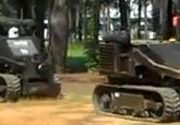 Recently, some clients asked AMREL to build an Operator Control Unit (OCU) for their Unmanned Ground Vehicle. No surprise there; we dominate that particular application. What was noteworthy was the specific form factor that they requested. They wanted it to be a wearable computer, worn on the wrist.
Recently, some clients asked AMREL to build an Operator Control Unit (OCU) for their Unmanned Ground Vehicle. No surprise there; we dominate that particular application. What was noteworthy was the specific form factor that they requested. They wanted it to be a wearable computer, worn on the wrist.
We ran a simple experiment with the clients. We strapped a small computer to their wrist and had them run some typical UGV commands. Soon, they discovered that their arms grew tired supporting the computer. The clients agreed to have their OCU installed in the traditional, if less exotic, form factor of a handheld.
Notice that the wrist-mounted form factor wasn’t discarded for technological reasons. AMREL has become quite adept at developing small, powerful, ATOM-based computer platforms, which would be perfect for wearable solutions. Rather, this innovative approach was discarded, because the wrist form factor proved impractical for this particular use.
Novelty is not necessary
Call this “The Minority Report” syndrome. In that movie, Tom Cruise used broad gestures to interact with a computer. Noted User Interface expert Jakob Nielsen pointed out that this futuristic technology is too tiring as a primary method for interacting with a computer (Usability in the Movies — Top 10 Bloopers).
The novelty of a new technology sometimes blinds us to its practicality. Just because we can do it doesn’t mean that we should. This is an especially important lesson for Defense vendors who are trying to use today’s technology to build tomorrow’s weapons. There is always a temptation to use the latest innovation just to stay ahead of the curve, even when it may be inappropriate.
Can you hear me now?
Consider voice input, a technology associated with the future ever since it was featured in the original Star Trek television series. If warfighters used voice input to interact with computer systems, their hands would be free to operate weapons. Voice input has been proposed as a method for interacting with semi-autonomous unmanned systems. Imagine soldiers barking orders to a robot as one would to a dog.
Yet, voice input will probably find only limited use. For one thing, combat can be quite noisy, not a conducive environment for verbal commands. More importantly, voice doesn’t transmit information as fast, accurately, or efficiently as other methods. We all have had the frustrating experience of using a torrent of useless words to describe something over the telephone, when a simple drawing or even a gesture would have been far quicker and more effective. Even on Star Trek, the bridge personnel pounded away on keyboards.
Smaller is not better
Moore’s Law, as well as other technological innovations, has enabled the creation of ever smaller computer platforms. Since soldiers are overburdened with weight, this is a welcomed development.
Will the future battlefield computer be unbelievably tiny? Not necessarily. A smaller screen is more difficult to use than a larger one (Mobile Content Is Twice as Difficult). To its credit the ARMY, in its drive to field a smartphone, has placed the emphasis on creating an interoperable environment for mobile applications, rather than committing to a specific form factor (The ARMY’s Smartphone may not always be a Smartphone). The weight vs. screen size tradeoff will have to be evaluated on a case-by-case basis.
3D or not 3D
In the same blog post in which he derides gesture-driven interfaces, Jakob Nielsen criticizes the use of 3D imaging. People are hardwired for 2D, he argues, and three-dimensional displays make tasks more difficult.
Nielsen bases his User Interface expertise on research, rather than speculation. However, research demonstrates that for typical UGV operations, a three-dimensional interface makes tasks easier and provides users with a greater measure of success (War and depth: Why your battlefield robot needs 3D).
Why the discrepancy? Jakob Nielsen is primarily concerned with website navigation. It could very well be true that 3D is a poor interface for that task, while a great one for UGV operations.
Look before you learn
However, I suspect there’s another factor in play here. Participants in Nielsen’s research probably had never used a 3D interface before. The more familiar 2D would have been easier to use. This points to a general problem with all novel technology: the learning curve.
There already is a dramatic increase in the demand on our soldier’s learning capabilities. Army Forces Command, Gen. David Rodriguez said “In my first 20 years in the Army, we probably got about 20–30 new systems. In 15 months [in Afghanistan] when I was a division commander, I got 172 new ones” (The Army’s thinner, high-tech force of tomorrow).
If we apply novel technologies on a case-by-case basis, which only seems common sense, will we end up with a bewildering menagerie of systems, each with its own instruction manual, and its own set of skills? At some point, will the demand of learning so many different systems overwhelm even the brightest professional soldier?
It can be argued that the whole point of an application-driven system is to consolidate multiple functions into one system. A smartphone can be used for GPS, mapping, targeting, fire control, and even making calls. This trend would impede the proliferation of platforms, which would result from applying technology on a case-by case basis.
The future battlefield computer
As we can see, battlefield computers are caught in a tug of war between the familiar and the futuristic. Technology enables smaller platforms, but our vision, cognitive skills, ergonomic needs, and standard-size fingers favor larger screens, and conventional keypads. Some cutting-edge technologies are better for specific applications, but old-fashion solutions are more suited for others. We want as few platforms as possible, but the “best use” doctrine encourages a computer population explosion.
What do you think? What will the future battlefield computer look like? Leave your comments here or write editor@amrel.com.







Weight, size and dimensions have always been issues, and always will be. These issues are compounded by the need for rugged construction on the battlefield combined with the need for the soldier to read screen data in all light conditions and at the same time avoid any compromise to their location. The need to operate with gloves creates other problems and additionally impacts on size.
The inclination to develop and adopt particular technologies because we can, may also have the disturbing effect of encouraging technology to lead operational and tactical doctrine instead of the other way around.
The future computer systems and robots will be subjective and will required programming no more than the live creatures.